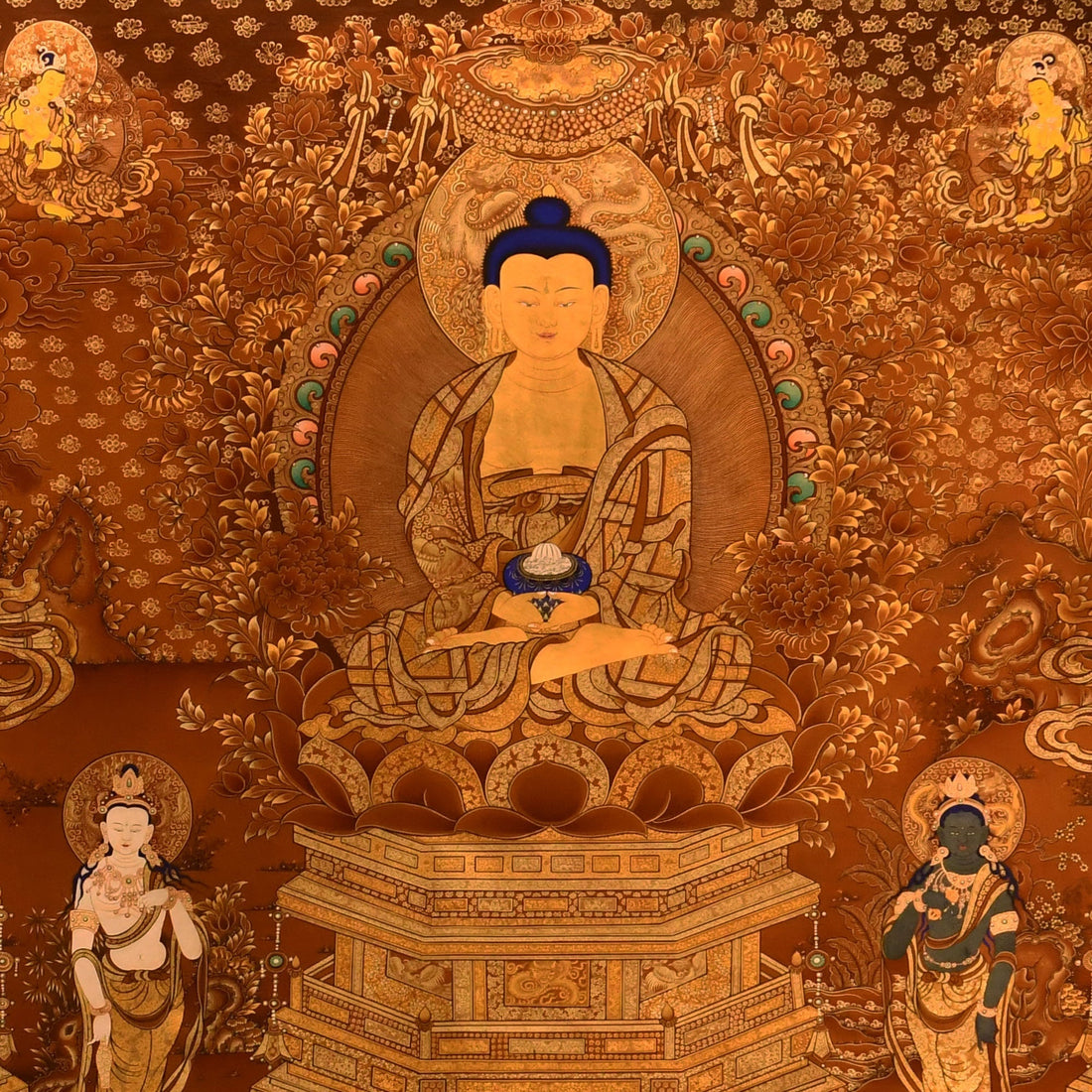Thangka paintings are more than intricate works of art—they are sacred objects imbued with spiritual meaning. These vibrant representations serve as visual prayers and guides to the divine, offering a connection between the earthly and the celestial. By drawing inspiration from this profound tradition, our designs honor the depth of Tibetan Buddhism and bring these spiritual symbols into modern fashion, so you can carry a piece of this ancient wisdom wherever you go.
Thangka

Introduction to Thangka
Thangka (also spelled Tangka) is a traditional Tibetan Buddhist painting on fabric, usually depicting Buddhist deities, mandalas, or scenes from the life of the Buddha. These intricate and colorful works of art serve not only as visual representations of Buddhist teachings but also as tools for meditation, reflection, and spiritual practice.
Originating in Tibet, Thangkas are an integral part of Tibetan Buddhism. The word “Thangka” comes from the Tibetan language, meaning "that which is rolled up" — a reference to how these artworks are often rolled up for storage or transport. Typically created using pigments made from natural minerals, gold leaf, and other organic materials, Thangkas can be quite large or small, and they are often framed with decorative brocade cloth.
The Significance of Thangka in Tibetan Buddhism
Thangkas are not just beautiful pieces of art; they are sacred objects used in meditation and teaching. Each Thangka represents different aspects of Buddhist philosophy, symbolism, and spiritual practices, and they are designed to aid the practitioner in focusing their mind during meditation. The Thangka serves as a focal point for visualization, contemplation, and invoking the blessings of the deities depicted.
Here are some of the key purposes and meanings behind Thangka paintings:
-
Spiritual Guidance Thangkas are often created to depict the lives of Buddhas, Bodhisattvas, and important spiritual figures. These figures serve as guides for practitioners, showing the path to enlightenment. Thangkas can also depict various stages of the Buddha’s life, including key events such as his birth, his renunciation of worldly life, his attainment of enlightenment, and his teachings.
-
Meditation Tool Thangkas provide a visual aid for meditation, helping practitioners to focus their attention during prayer or meditation sessions. The detailed imagery and symbols within the Thangka guide the mind to remain calm, focused, and centered. In Tibetan Buddhism, practitioners often meditate on a Thangka of a particular deity to invoke blessings or gain wisdom from the figure represented.
-
Vibrational Energy and Blessings The creation of a Thangka is often considered a spiritual act in itself. The artist must engage in prayer and ritual before creating the piece, seeking blessings for the work. Once completed, the Thangka is often consecrated by a lama or monk, who performs ceremonies to imbue the artwork with spiritual energy. Thangkas are believed to radiate blessings to those who view them or engage with them in meditation.
-
Sacred Geometry and Symbolism The design of a Thangka follows very specific guidelines dictated by Tibetan Buddhist tradition. Every aspect, from the geometry of the mandalas to the placement of the deities, is based on sacred teachings. These designs are meant to represent the harmonious order of the universe and the interconnectedness of all things. The use of color, patterns, and imagery are symbolic and have deep spiritual meanings.
Common Themes in Thangka Art
-
Deities and Bodhisattvas Many Thangkas feature prominent Buddhist deities and Bodhisattvas, who embody specific qualities or virtues. For example, Avalokiteshvara, the Bodhisattva of Compassion, is often depicted with multiple arms to represent the ability to help many beings simultaneously. Manjushri, the Bodhisattva of Wisdom, is typically shown holding a sword that represents the cutting away of ignorance.
-
Mandalas Mandalas are often central to Thangka paintings, representing the universe and the ultimate reality. The intricate patterns within a mandala are designed to help the practitioner visualize the universe in a spiritual sense. They are used as tools for meditation and reflection, guiding the practitioner to a higher state of consciousness.
-
Scenes from the Buddha’s Life Thangkas frequently depict scenes from the life of the Buddha or significant moments in his spiritual journey. These include his birth, enlightenment, teachings, and his ultimate entry into nirvana. These scenes serve as inspiration for practitioners, reminding them of the path toward spiritual awakening.
-
Wheel of Life (Bhavacakra) Another common theme in Thangkas is the Wheel of Life, also known as Bhavacakra. This symbolic wheel depicts the cycle of birth, death, and rebirth (samsara), showing the journey of the soul through various states of existence. The imagery typically includes figures such as the demon of death and representations of the six realms of existence.
Thangka Art in Modern Design
Thangka paintings, with their intricate and symbolic designs, have found their way into modern culture and design, including jewelry, home decor, fashion, and accessories. The spiritual significance of these artworks, combined with their visually striking appearance, makes them ideal for modern reinterpretations.
In jewelry design, Thangka-inspired pieces often feature sacred symbols like lotus flowers, deities, and mandalas. These symbols are not only visually stunning but also carry deep meaning. By incorporating elements from Thangka art into modern pieces, we can bring a sense of spirituality, peace, and wisdom into daily life.
Thangka Art in Zodori’s Designs
At Zodori, we take inspiration from the ancient and sacred art of Thangka painting, infusing our jewelry and accessories with the spiritual elements and rich symbolism found in this tradition. Whether it's a pendant featuring a deity, a bracelet with mandala patterns, or earrings symbolizing wisdom and compassion, each of our designs is carefully created to reflect the beauty and spiritual depth of Thangka art.
We believe that Thangka-inspired pieces do more than enhance your style—they also bring a sense of balance, mindfulness, and spiritual connection to the wearer. Each item in our collection serves as a visual reminder of the profound teachings found in Tibetan Buddhism, offering a unique way to carry the wisdom of the ages with you, wherever you go.


